In Yoga: Bend Back, Don’t Swayback!
Not all backbends are created equal. Healthy backbends happens at the lowest lumbar level (L5-S1); unhealthy backbends happen higher up in the lumbar spine.

Cecily Frederick (Gokhale Method teacher, Madison, Wisconsin), doing a back dive with a healthy L5-S1 backbend.

This yogini is backbending (unhealthily) almost entirely in the upper lumbar spine.
The L5-S1 joint is unique in having saddle-like properties and is capable of quite extreme extension (backbending) without injury.

B.K.S. Iyengar demonstrates a healthy 90 degree backbend that happens exclusively at the L5-S1 joint. Iyengar was one of the world's foremost yoga teachers until his death at age 95.
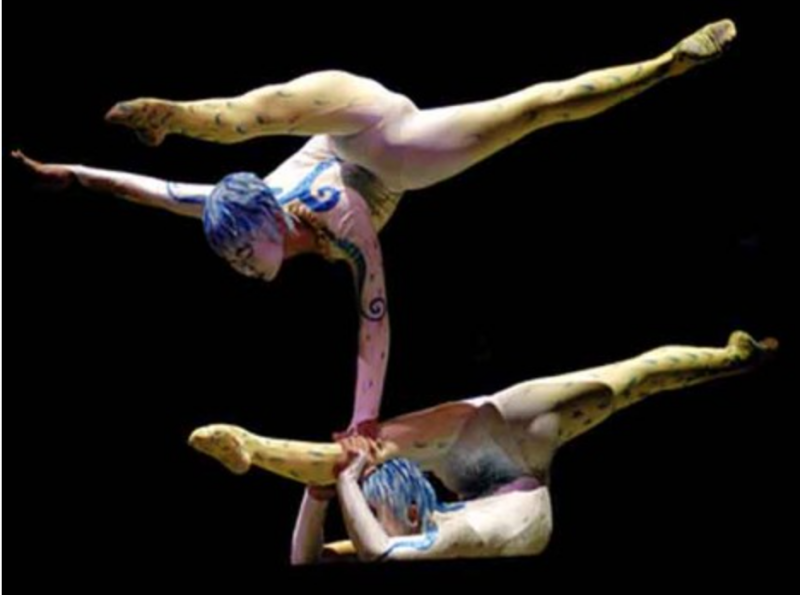
Peking Acrobats are trained to perform extreme backbends. The backbends happen exclusively at L5-S1, which makes them sustainable.
Higher up in the lumbar spine, repeated, sustained, or extreme extension results in wear and tear and injury in the related discs and vertebrae.

This young gymnast exhibits a classic gymnastics pose, with a significant (unhealthy) sway in her upper lumbar spine. Gymnasts are notoriously prone to back pain and injury.
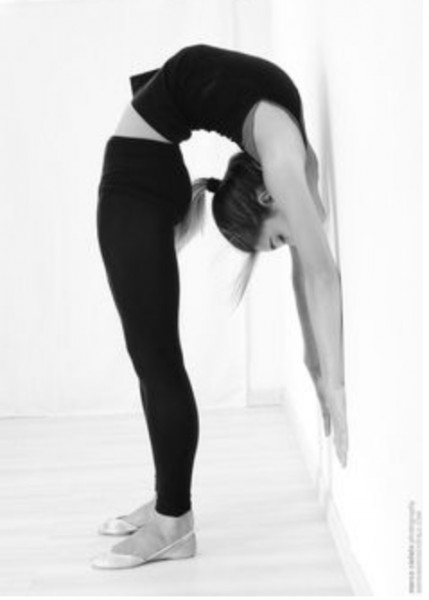
The majority of this dancer’s backbend happens at a single level in her upper lumbar spine that is not adapted for extreme backbending (ouch!).
The distinction between upper and lower lumbar curvature is rarely made, neither for baseline positions like standing and sitting, nor for acrobatic and yoga positions like backbends. This lack of distinction is true in modern lay culture (see post on Forward Pelvis) as well as in the medical literature (see this cross sectional study on the Correlation between Radiologic Sign of Lumbar Lordosis and Functional Status in Patients with Chronic Mechanical Low Back Pain). Not surprisingly, findings involving a crude compound of all lumbar curvature are confused and contradictory. I have found only one scientific study on lower back pain that makes a distinction between upper and lower lumbar curvature - the findings are consistent with the Gokhale Method's claims about a "J-spine" being healthier than an "S-spine."
I consider that the significant back problems I suffered in my mid-20’s resulted in part from poorly executed yoga and gymnastic backbends in my childhood, as well as a chronic baseline extension (sway) of my upper lumbar spine. I was rewarded for my “flexibility” both in gymnastic competitions and as a yoga presenter and teacher—I received applause, awards, and signups for classes. Almost no one saw that I was systematically bending backwards in a problematic place.

Me in the INDUS fashion show (Mumbai, 1973) sporting a hand-me-down dress - and a significant sway.
I do recall my Bharatanatyam dance teacher Kutti Krishnan being vaguely disturbed by my baseline stance. He wasn’t able to articulate what exactly the problem was, or how to correct it, but I remember him trying to imitate my stance to help me out. It didn’t work, he stopped trying to correct me, and my sway persisted unchecked into adulthood, when it manifest as a problematic and then surgical back in my mid-20’s.
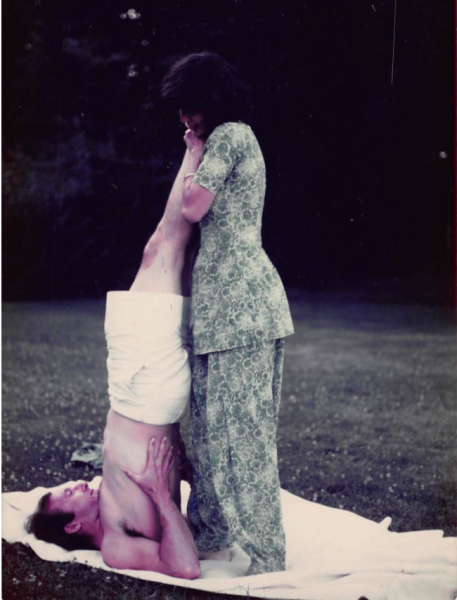
An old image of me teaching yoga as best as I knew how in 1979, standing with a sway in my back (and putting extreme flexion into my student's neck.)
To learn a healthy backbend, start with an “infant cobra,” in which you plan on lifting no more than two inches off the ground. Begin by lying face down with your hands placed near your armpits. Before lifting, engage an extremely strong rib anchor. Augmenting the rib anchor hard against the tendency to sway, press up an inch or two from the ground. Keep the neck aligned with the spine.
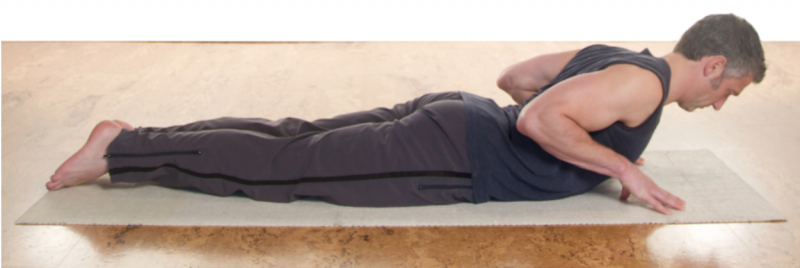
Notice how in this healthy baby cobra, the backbend takes place only at L5-S1 at the base of the lumbar spine, right above the butt.
Don’t expect to be entirely successful at the start. It’s challenging to eliminate a habitual sway entirely so tolerate a small amount of arching in your back unless that hurts. As you practice, slip a hand back to your midline groove and make sure the arch is not too accentuated.
If you backbend at L5-S1 and strongly engage your rib anchor muscles, the front lower border of your ribcage will not protrude, but rather remain flush with your torso. A bend higher in the lumbar spine will result in the ribs protruding visibly from the contour of the abdomen.

The extent of protrusion of the ribcage is a fairly reliable index of sway in the low back. This bridge position shows healthy spinal curvature, where the backbend happens almost exclusively at the L5-S1 joint. There is no protrusion of the ribcage from the smooth contour of the abdomen.
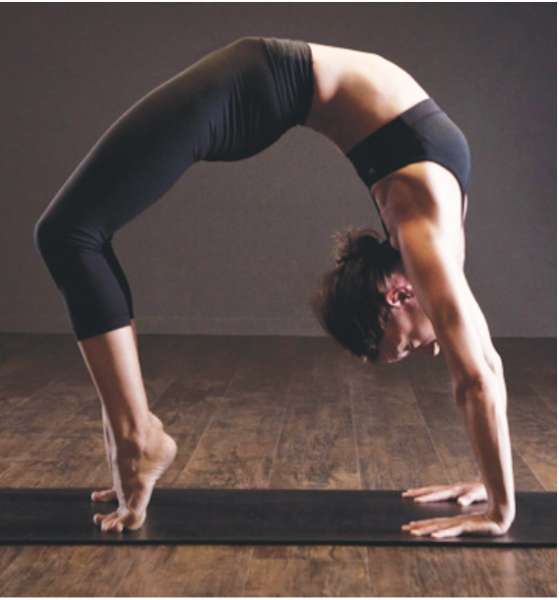
This yoga student’s backbend happens at L5-S1 (which is good) as well as the upper lumbar spine (not so good)- her rib cage protrudes slightly from the contour of her abdomen.
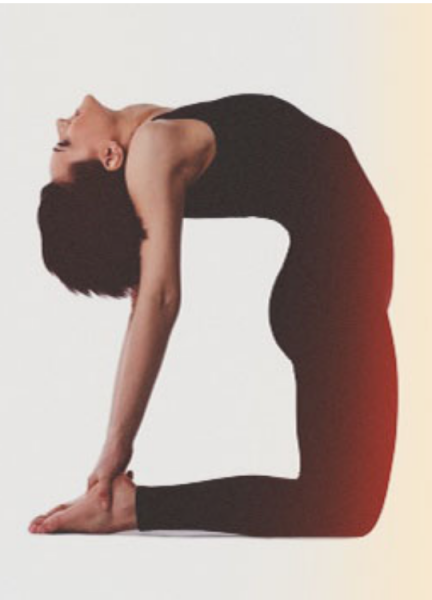
This student backbends entirely in her upper lumbar spine (ouch) and we see her ribs lift away from her abdomen a great deal.
As you get used to the practice of intensifying the rib anchor corresponding to the challenge that you’re imposing on it, you can increase the extent of your cobra by degrees and perform other types of backbends.
For extreme backbends, we recommend you leave them to the professionals. B.K.S. Iyengar was known to practice yoga eight hours a day. The Peking Acrobats are also singularly dedicated to their craft. For some of us, bending back in the shower to avoid shampoo coming into our eyes is the most practice we'll have in backbending. It's enough to keep us flexible and healthy as we enjoy watching what others are able to do.

B.K.S. Iyengar doing an inversion combined with a healthy backbend.

Comments
Yes, use our roller - but
Yes, use our roller - but first you want to master the basics, especially shoulder roll and elongating the neck. At the risk of sounding like a broken record, I recommend taking our Gokhale Method Foundations course.
As a Yoga teacher I'm sure
As a Yoga teacher I'm sure people out there are thinking "how are those pretty extreme yoga poses relevant to me - I would never try and put myself in those positions anyway".
The really relevant thing about looking at these very deep backbends is that they make it easy to see the significantly different points at which our spines can bend. This is more difficult to observe in daily life, but the more subtle patterns we cultivate in everyday living are still hugely important - their impact accumulates when it's our way of being, day in, day out, year after year.
In less extreme postures the points of articulation are less visually obvious to the untrained eye, and yet it is here that we all need to pay attention, for any problems in our everyday patterns will only magnify whenever we do increase our range of movement.
That is why it is so essential to 'sweat the small stuff' and learn how to recognise and embody healthy posture in both daily life and 'easier' yoga poses. I always encourage Yoga practitioners to take the Gokhale Method Course - it will enrich and transform their practise and understanding of their body, not to mention avoid injury.
Absolutely excellent. Taking
Absolutely excellent. Taking the bend at L5-S1 made all the differrence to me in my backbending practice. Thank you for making this point crystal clear in this article, and with these images.
I studied Iyengar Yoga exclusively for the first 7 years or so of my nearly 30 years of Yoga studies, with senior Iyengar Yoga teachers, and on occasion with Mr. Iyengar himself. In those 7 initial years of Yoga classes I recall only twice the action of anteverting the pelvis was mentioned and the references were vague and metaphorical. Pelvic anteversion was never mentioned by any teacher I have subsequently studied with. For backbending I would have been better off copying the teacher rather than listening to the teacher. Thankfully Esther Gokhale explains backbending so well!
What about the yoga Cat/Cow,
Many people sway the small of
Many people sway the small of the back and/or tuck the pelvis habitually. The usual way of doing cat/cow can reinforce what's already a bad habit. I like to modify Cat/Cow so it's more useful - extending the thoracic area in Cat, and flexing the upper lumbar area (if it tends to sway) in Cow.
Add New Comment
Login to add commment
Login